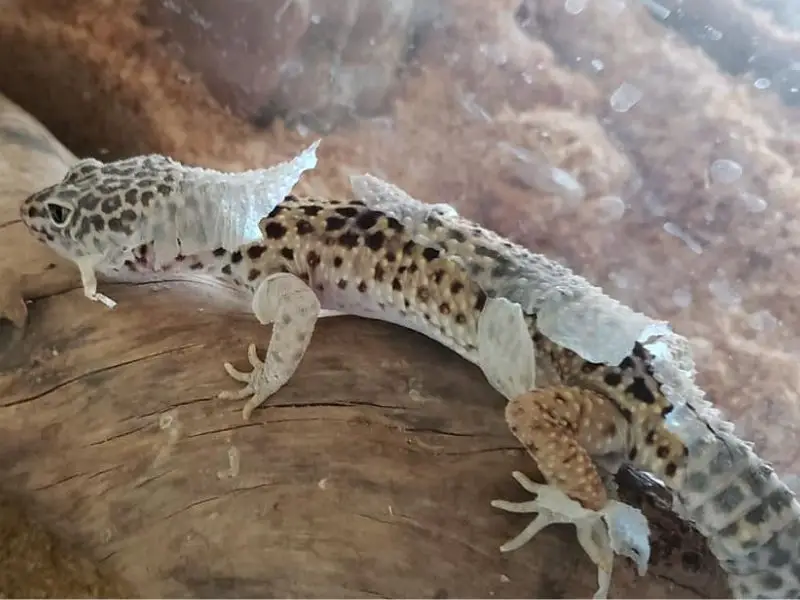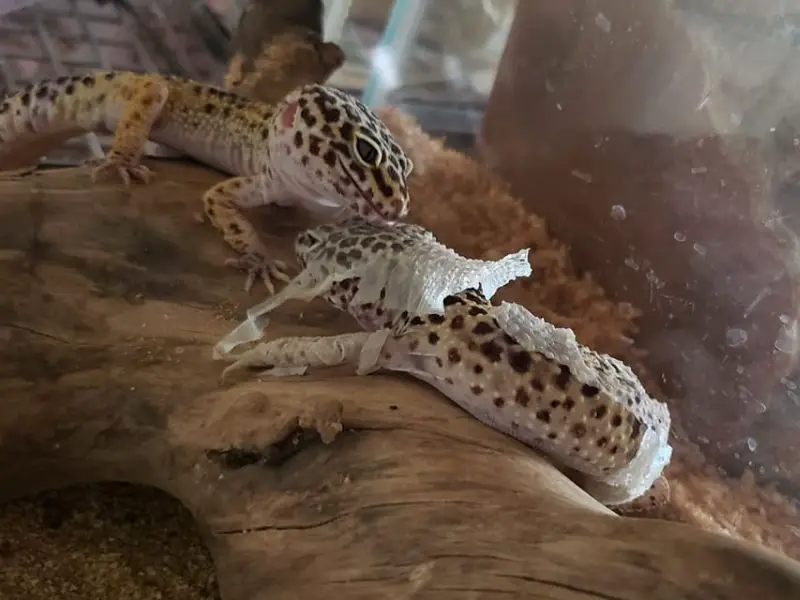Leopard geckos remove the outer layer of their skin called the epithelial skin and replace it with new skin cells. This process ends when the cells that generate new skin begin to divide from the old layers. When the two layers of skin begin to divide, the gecko becomes pale and gray and this is when the reptile breeder knows their pet gecko is about to shed. The removal of old skin cells and replacing them with new ones is known as shedding.
What is shedding in geckos?

Leopard geckos shed for various reasons and among the main reason is to fit in their growing body. This is because reptile skin is not as elastic as mammals, and growing geckos need to routinely shed and grow new skin. Shedding not only helps geckos grow but also helps the reptiles repair wounds or any skin damages.
Baby geckos shed more often than adult geckos due to their rate of growth. It is also important for leopard geckos to shed off old skin as it helps in repairing any wounds or damage on their skin.
Leopard geckos have a dramatic shed as their skin goes from bright and colorful to a pale and dull color. This is exciting for the pet breeders to watch as after the shedding process, their pet geckos become more vibrant and may gain new colors or patterns.
If your juvenile gecko is unable to shed well, the stuck shed may cut out circulation on areas the skin is stuck and if not well removed this will lead to chronic problems. Normally, geckos have problems removing shed skin from their toes and tail sometimes and without intervention, these parts may eventually fall off.
Leopard geckos, unlike other geckos shed their skin in almost one whole piece. The reptiles pull or rub off the old skin with their mouth and some geckos eat it to replenish the nutrients found in the dead cells.
How often do leopard geckos shed?
There are different aspects that determine a gecko’s shedding schedule. Nutritional status rate of growth, humidity and hydration are among the main factors.
Young geckos shed once every two weeks while the adult geckos shed once every four to eight weeks. Baby geckos shed more often than adult geckos because they feed more and are constantly growing to attain the full-size adult gecko body.
When geckos are about to shed, their skin starts changing color from bright and vibrant to dull and ashy. The old skin is detached from the body and it slowly starts to peel off gradually separating from the body.
Loss of appetite is also another sign to look out for to tell if a gecko is about to shed. The reptile will stay off food a week before they start shedding and some will go for a few more days without eating after shedding.
Other geckos become moody or extra aggressive during the shedding period.
Once your leopard gecko starts showing theses shedding signs, you will need to raise the humidity in the tank and the shedding process should last 24-48 hours. Geckos shed more frequent depending on the rate of their growth
What affects the time between sheds?
There are 3 main factors that affect the time between sheds for leopard geckos which are:
Tank humidity and hydration
The natural habitat of leopard geckos is the semi-arid desserts with enough humidity for the reptiles to shed well. Reptiles in captivity require the right amount of humidity to mimic their original habitat and without enough moisture the skin gets stuck which leads to further complications. As a pet breeder, try to have husbandry that is almost duplicate form the natural environment of the geckos.
As an addition to the vivarium, it is important for reptile owners to have a humidity hide box with moist substrate. The box is kept inside the reptile tank and helps in boosting the humidity by creating a more natural environment for the gecko to shed in with humidity levels between 70%-80%. Proper humidity helps geckos pull out the dead skin and reduces any chances of stuck shed.
Hide box can be easily made at home by using containers and moist substrate. The container should be big enough for your gecko but also small enough to fit inside the vivarium.
The hide box creates a micro-climate space where your gecko can go in and out if they want to and as much as they need it. Without enough moisture, your gecko will experience a hard time pulling off the skin dry skin and have high chances of experiencing stuck shed.
Proper consistent hydration in the diet of your leopard gecko also helps the gecko shed well and easy. Throughout your pets’ diet, always ensure the food is well balanced with the right nutrients and the availability of clean and fresh drinking water every day.
Hypovitaminosis A or nutritional status
Vitamin A deficiency will lead to dysecdysis which means abnormal shedding. Many gecko breeders feed their geckos an only cricket diet which puts the gecko at higher risk of developing this condition. It Is important to ensure a well-balanced diet for your pet gecko. Try mixing a variety of insects and worms to balance out the diet and also keep the feeding time interesting for your pet gecko.
READ MORE: Best foods to feed your leopard geckos.
Growth Rate
Baby leopard geckos shed on a more frequent schedule before they attain the adult gecko body. The reptile skin does not expand and the geckos grow out of old ones as their sizes increases making the baby geckos shed more times than the full-grown adult gecko. A gecko’s shedding is more tied to growth rather than a schedule or season.
Signs your gecko is about to shed

Your leopard gecko will dramatically change its color from a bright colored pattern to a dull grey shade. This happens when the gecko is just about to shed and the color change is a fascinating time for the breeder as well.
Leopard geckos may go without food for a week before shedding and this is one of the signs to look out for. During the period, it is best to remove any leftover food in your geckos’ tank as dead insects are a breeding ground for bacteria.
Crawling insects may also irritate the skin of your shedding gecko and it is best to not feed your reptile during this time. If your gecko shows signs of fasting, do not be alarmed as they will pick up on their appetite after they finish shedding.
Some geckos might also go for a few more days without food but this should not be reason of much concern. Geckos use the fat stored in their tail and eating the dead skin also provides them with nutrients to get them through the shedding period.
The other sign that you gecko is about to shed is the sadden change of skin color to very dull colors.
The reptiles replace the dead skin with a new one, which is brighter and more vibrant.
Stuck Shed
Lack or low humidity is the major problem that causes stuck shed in leopard geckos. If stuck shed is not removed, it leads to chronic health issues. Humidity is very important to help soften the dead skin so that the gecko can easily pull it off or rub it off against rough surfaces. Stuck shed is the biggest problem geckos have during the entire shedding process.
If any stuck shed is not removed early enough, it normally leads to future chronic health issues for the gecko. Dead skin tightens around certain body parts of the gecko’s and over time, forms a tight ring cutting off circulation.
When stuck shed is noticed and removed early enough, there will be no much harm done to the gecko. A few weeks may cause cuts or injuries around where the shed got stuck. In very severe cases where stuck shed cuts off circulation for a longer period of time, the area around the dead skin starts turning black. This indicates dead tissue and the parts eventually fall off or get cut off. This disfigures the gecko for the rest of its life.
The most common part for shed to get stuck is between the toes of the gecko. Other parts may be the tail or the eye. Stuck shed in the eyes of your leopard is a matter of concern and should be acted on immediately.
How to help leopard gecko shed
The first way to help leopard geckos shed is by ensuring the diet of the reptile is supplemented with all essential vitamins. In addition, you can get your gecko a hide box and place it in his vivarium as soon as you notice signs of your gecko is about to shed. However, if your gecko does not shed well or has a remaining stuck shed, this is what you should do:
Stuck shed in the toes
A warm bath helps geckos remove stuck shed between toes. The bath should be shallow, warm and should be for a few minutes. Put some warm water in a small plate and soak your gecko for about 15 minutes. The water should just cover his toes and as soon as the water starts getting cold, remove your gecko from the bath.
After the bath, pull the softened skin carefully with medical-quality tweezers. Gently brushing with a Q-tip usually does not work for toes, but you can try if the amount of skin is minimal. Pulling dry skin off your pet will harm him.
Stuck shed around the eyes
For shed stuck around the eyes and other parts of the body, create a sauna for your gecko. Put a towel soaked in warm water in a clean plastic container, with a lid and some air holes. Leave the gecko in there for half an hour. When you get him out, try removing the leftover skin with a moist Q-tip.
During your gecko shedding, you should not interfere as long as you have provided the necessary requirements to help the gecko shed. When you notice a stuck shed, it is best to try the above methods as pulling the gecko’s skin might harm them.
Do leopard geckos eat their shed?
Leopard geckos eat their shedding skin and the shedding process can be tedious to the gecko therefore it eats the skin as it sheds as a way of replenishing energy used. The dead skin has contained nutrients that the gecko reabsorbs.
Geckos also eat their own skin to cover their tracks, this way, a predator will not be able to trace the reptile. Leopard geckos are known to be clean as they use one corner of their tank as their bathroom. They remove the shed and eat in efficient ways.
READ NEXT: Brumation in Leopard Geckos: Signs, Care and Duration
